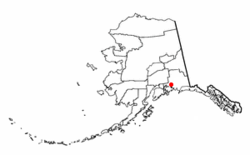Valdez, Alaska
Suacit | |
|---|---|
 Aerial view showing the townsite, the harbor, Port Valdez, the lower Mineral Creek valley, and Blueberry Hill | |
 Location of Valdez, Alaska | |
| Coordinates: 61°7′51″N 146°20′54″W / 61.13083°N 146.34833°W | |
| Country | United States |
| State | Alaska |
| Census Area | Chugach |
| Incorporated | June 11, 1901[1] |
| Government | |
| • Mayor | Sharon Scheidt |
| • State senator | Mike Shower (R) |
| • State rep. | George Rauscher (R) |
| Area | |
• Total | 271.91 sq mi (704.24 km2) |
| • Land | 212.69 sq mi (550.86 km2) |
| • Water | 59.22 sq mi (153.37 km2) |
| Elevation | 98 ft (30 m) |
| Population (2020) | |
• Total | 3,985 |
| • Density | 18.74/sq mi (7.23/km2) |
| Time zone | UTC−9 (Alaska (AKST)) |
| • Summer (DST) | UTC−8 (AKDT) |
| ZIP code | 99686 |
| Area code | 907 |
| FIPS code | 02-82200 |
| GNIS feature ID | 1412465 |
| Website | [1] |
Valdez (/vælˈdiːz/ val-DEEZ; Alutiiq: Suacit) is a city in the Chugach Census Area[a] in the U.S. state of Alaska. According to the 2020 US Census, the population of the city is 3,985, up from 3,976 in 2010.[4] It is the third most populated city in Alaska's Unorganized Borough.
The city was named in 1790 after the Spanish Navy Minister Antonio Valdés y Fernández Bazán. A former Gold Rush town, it is located at the head of Port Valdez on the eastern side of Prince William Sound. The city was incorporated in 1901, but did not flourish until after the road link to Fairbanks was constructed in 1910. It suffered catastrophic damage during the 1964 Alaska earthquake, and is located near the site of the disastrous 1989 Exxon Valdez oil tanker spill. Today, it is one of the most important ports in Alaska, a commercial fishing port as well as a freight terminal. Valdez is also the terminus for the Trans-Alaska Pipeline System.
- ^ 1996 Alaska Municipal Officials Directory. Juneau: Alaska Municipal League/Alaska Department of Community and Regional Affairs. January 1996. p. 156.
- ^ "2020 U.S. Gazetteer Files". United States Census Bureau. Retrieved October 29, 2021.
- ^ United States Census Bureau. "Changes to Counties and County Equivalent Entities: 1970-Present". census.gov. Retrieved February 28, 2020.
- ^ "2020 Census Data - Cities and Census Designated Places" (Web). State of Alaska, Department of Labor and Workforce Development. Retrieved October 31, 2021.
Cite error: There are <ref group=lower-alpha> tags or {{efn}} templates on this page, but the references will not show without a {{reflist|group=lower-alpha}} template or {{notelist}} template (see the help page).